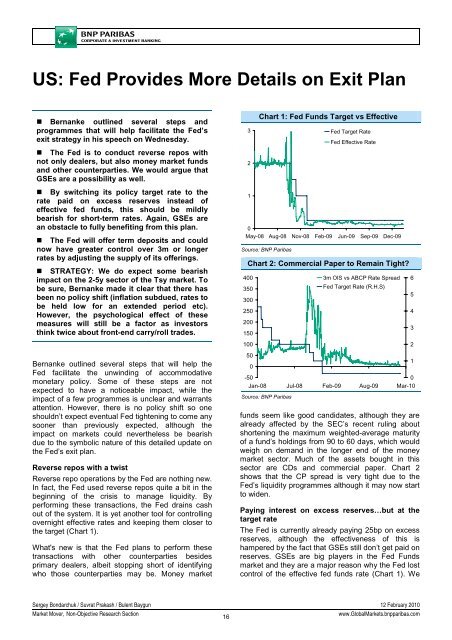Market Mover - BNP PARIBAS - Investment Services India
Market Mover - BNP PARIBAS - Investment Services India
Market Mover - BNP PARIBAS - Investment Services India
Create successful ePaper yourself
Turn your PDF publications into a flip-book with our unique Google optimized e-Paper software.
US: Fed Provides More Details on Exit Plan<br />
• Bernanke outlined several steps and<br />
programmes that will help facilitate the Fed’s<br />
exit strategy in his speech on Wednesday.<br />
• The Fed is to conduct reverse repos with<br />
not only dealers, but also money market funds<br />
and other counterparties. We would argue that<br />
GSEs are a possibility as well.<br />
3<br />
2<br />
Chart 1: Fed Funds Target vs Effective<br />
Fed Target Rate<br />
Fed Effective Rate<br />
• By switching its policy target rate to the<br />
rate paid on excess reserves instead of<br />
effective fed funds, this should be mildly<br />
bearish for short-term rates. Again, GSEs are<br />
an obstacle to fully benefiting from this plan.<br />
• The Fed will offer term deposits and could<br />
now have greater control over 3m or longer<br />
rates by adjusting the supply of its offerings.<br />
• STRATEGY: We do expect some bearish<br />
impact on the 2-5y sector of the Tsy market. To<br />
be sure, Bernanke made it clear that there has<br />
been no policy shift (inflation subdued, rates to<br />
be held low for an extended period etc).<br />
However, the psychological effect of these<br />
measures will still be a factor as investors<br />
think twice about front-end carry/roll trades.<br />
1<br />
0<br />
May-08 Aug-08 Nov-08 Feb-09 Jun-09 Sep-09 Dec-09<br />
Source: <strong>BNP</strong> Paribas<br />
Chart 2: Commercial Paper to Remain Tight?<br />
400<br />
3m OIS vs ABCP Rate Spread 6<br />
350<br />
Fed Target Rate (R.H.S)<br />
5<br />
300<br />
250<br />
4<br />
200<br />
3<br />
150<br />
100<br />
2<br />
Bernanke outlined several steps that will help the<br />
Fed facilitate the unwinding of accommodative<br />
monetary policy. Some of these steps are not<br />
expected to have a noticeable impact, while the<br />
impact of a few programmes is unclear and warrants<br />
attention. However, there is no policy shift so one<br />
shouldn’t expect eventual Fed tightening to come any<br />
sooner than previously expected, although the<br />
impact on markets could nevertheless be bearish<br />
due to the symbolic nature of this detailed update on<br />
the Fed’s exit plan.<br />
Reverse repos with a twist<br />
Reverse repo operations by the Fed are nothing new.<br />
In fact, the Fed used reverse repos quite a bit in the<br />
beginning of the crisis to manage liquidity. By<br />
performing these transactions, the Fed drains cash<br />
out of the system. It is yet another tool for controlling<br />
overnight effective rates and keeping them closer to<br />
the target (Chart 1).<br />
What's new is that the Fed plans to perform these<br />
transactions with other counterparties besides<br />
primary dealers, albeit stopping short of identifying<br />
who those counterparties may be. Money market<br />
50<br />
0<br />
-50<br />
0<br />
Jan-08 Jul-08 Feb-09 Aug-09 Mar-10<br />
Source: <strong>BNP</strong> Paribas<br />
funds seem like good candidates, although they are<br />
already affected by the SEC’s recent ruling about<br />
shortening the maximum weighted-average maturity<br />
of a fund’s holdings from 90 to 60 days, which would<br />
weigh on demand in the longer end of the money<br />
market sector. Much of the assets bought in this<br />
sector are CDs and commercial paper. Chart 2<br />
shows that the CP spread is very tight due to the<br />
Fed’s liquidity programmes although it may now start<br />
to widen.<br />
Paying interest on excess reserves…but at the<br />
target rate<br />
The Fed is currently already paying 25bp on excess<br />
reserves, although the effectiveness of this is<br />
hampered by the fact that GSEs still don’t get paid on<br />
reserves. GSEs are big players in the Fed Funds<br />
market and they are a major reason why the Fed lost<br />
control of the effective fed funds rate (Chart 1). We<br />
1<br />
Sergey Bondarchuk / Suvrat Prakash / Bulent Baygun 12 February 2010<br />
<strong>Market</strong> <strong>Mover</strong>, Non-Objective Research Section<br />
16<br />
www.Global<strong>Market</strong>s.bnpparibas.com
















